How to Build Calf Muscles for Size and Strength
Having strong calf muscles is beneficial for all sports. But, how do you work them out for size and strength? By knowing the best ways to target calves!
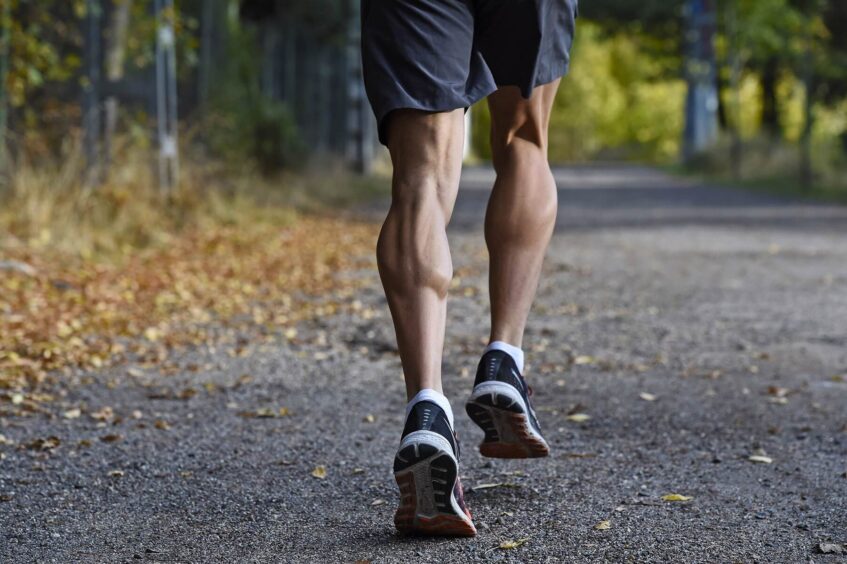
I have found my calf muscles to be the hardest body part to build. It's probably because I have naturally thin legs and small calves -- can you relate?
For a long time, I felt that I looked disproportionate. Although I was training my legs at the gym, my upper body was far more muscular.
Not only was I unhappy visually with my legs, but I was also missing out on many benefits of muscular calves.
As it turns out, by training smartly, I have trained my calves and found balance in my body. I just needed to get to grips with the science behind calf training and start doing the right exercises.
Stronger calves have improved my stamina and allowed me to do most cardio exercises for longer, including running, jumping, and squatting. This has also enabled me to build muscle in other places.
The Anatomy of the Calf Muscle
The calf muscle is actually two separate muscles. The soleus is the larger of the two and is situated beneath the gastrocnemius.
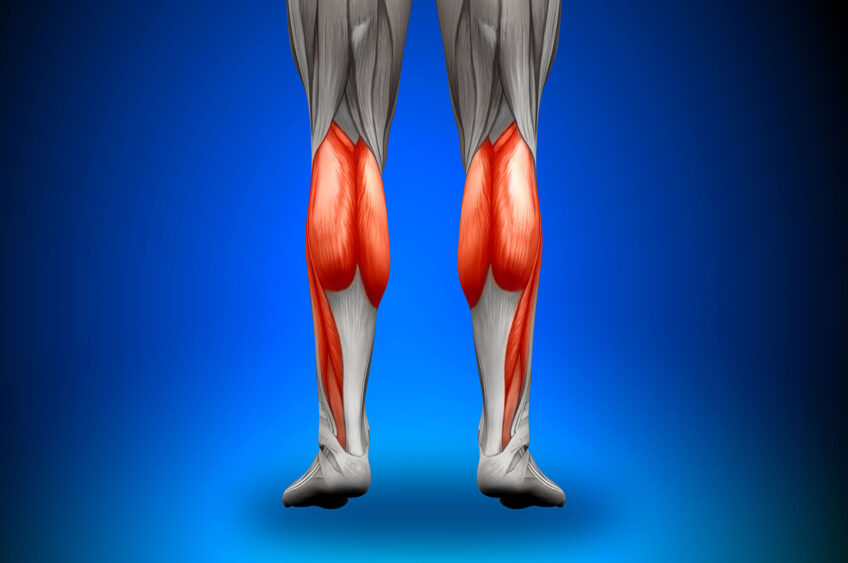
When most people think of the calf, they usually think of the gastrocnemius, the ball that contracts and works to push the foot down and helps you bend your knee.
The tibialis anterior also comes into play. It is a small muscle at the front of your lower leg. This can help develop size, power, endurance, shape, and strength.
These muscles require different approaches to build size.
Gastrocnemius
To target the gastrocnemius, straight-legged-heel raises are best — for example, standing calf raises, and donkey calf raises.
These two exercises work by keeping your legs straight and activating your calf. It can be tempting to relieve some pressure by bending your knees, but this will shift the exercise to working your soleus more. Keeping your legs straight will stop other muscles from coming into play.
Donkey raises are the best exercise, as when you are bent over, your gastrocnemius and hamstrings are stretched, which makes the workout more intense.
The gastrocnemius is comprised of fast-twitch muscle fibers. As a result, it responds to heavier weight, more sets, and fewer repetitions.
Soleus
The soleus is not visible, but it does give width to the back of your lower leg.
It is beneficial in many endurance activities and often takes over when the gastrocnemius is fatigued. To gain muscle in your calves, you must train both muscles.
To target the soleus, use bent-knee exercises like seated calf raises. Sitting down will mean that the gastrocnemius does not have much of a role.
The soleus is comprised of slow-twitch muscle fibers. Therefore, it responds to lightweight, more repetitions, and fewer sets.
Tibialis anterior
Although this is not technically a calf muscle, it adds more symmetry and makes your calves look larger.
The best way to train this muscle is with toe raises. Place your heel on a platform and put a dumbbell across your foot while lifting your toes as high as possible.
Fast-Twitch vs. Slow-Twitch Muscle Fibers
The gastrocnemius comprises fast-twitch fibers, and the soleus is slow-twitch.
Slow-twitch muscles can provide their energy; they can be worked over a long period but cannot generate a lot of force.
The best way to train slow-twitch muscles is to contract them for extended periods. As well as using lighter weights, use slow movements, and high repetitions.
Fast-twitch muscles can provide great force but are quick to fatigue.
They should be trained using heavier weights and fewer repetitions. They may also require longer resting between sets.
Benefits of Training Calves
When people want a stronger lower body, they often think about hamstrings, glutes, and quads and neglect their claves. However, calves are integral.
When running, you use nearly all of the muscles in your legs, but calves are most important. In one study, the overall muscle effort of claves in runners was 25% higher than in their quads. The soleus and gastrocnemius extend and flex your feet as you land and push off. They are also shock absorbers.
Because they are so well used, they also fatigue quickly. Therefore, having strong calf muscles is beneficial not just to running but to any sport. They bear your weight and stabilize your knees. Strong calves will prevent injury, protect joints, and improve your jumps, squats, and sprints.
Tips on Training Calf Muscles
One of the reasons that training your calf muscles is difficult is that you use them daily as you walk, yet they do not grow. For them to grow, they need a lot of work!
This may mean you must train them more frequently than other muscles. Aim for two or three times each week. You should also aim for slower reps, more volume, and longer duration.
Use heavier weights and do less of them. They are used to moving weight but not heavyweight.
You may need very high reps and concentration because they deal with a lot throughout the day. Aim for a two-second pause on each rep.
You should also train your claves flat-footed -- consider bare feet.
Stretching is essential for growth. Be sure to stretch your calves before and after you work on them. You can find some great calf stretches here.
My favorite way to stretch calves is against the wall or gym equipment.
Place the balls of one foot against the wall (at a 45-degree angle), then bring your body towards the wall.
Exercises
Find a routine that works for you, but try to aim for three exercises two or three times per week.
Standing Calf Raises
This exercise will target your gastrocnemius, which means you should use heavier weights and repeat them less.
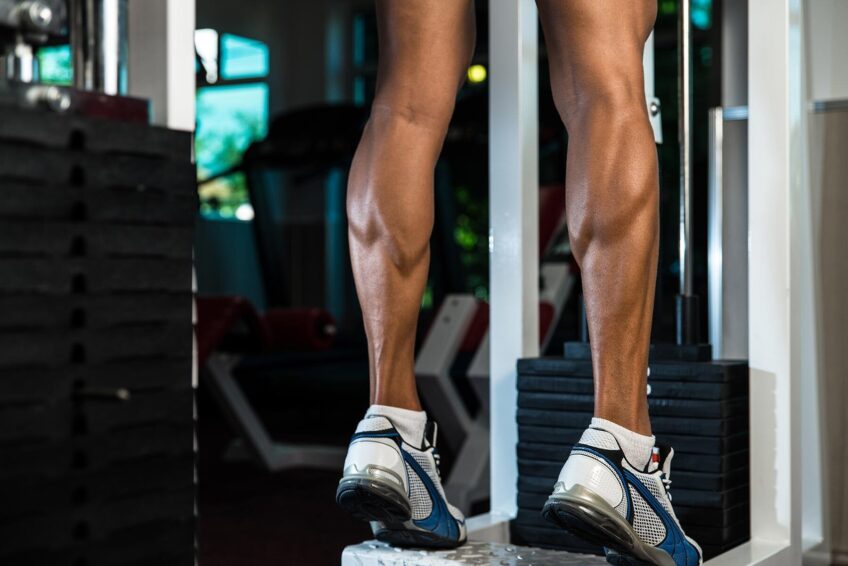
- Stand on a raised surface so your heels are off the ground, and keep your legs straight. You can hold onto something for support.
- Lower your heels so your calves are fully stretched.
- Then, push down with the balls of your feet and elevate your heels as high as possible.
- Repeat 8-10 times and do 4 sets.
You can also do Standing Calf Raises on a flat surface while holding a light weight in each hand.
Seated Calf Raises
Because your knees are bent, this exercise will target your soleus, so you should aim for lighter weights and more repetition. Holding the contraction is also important.
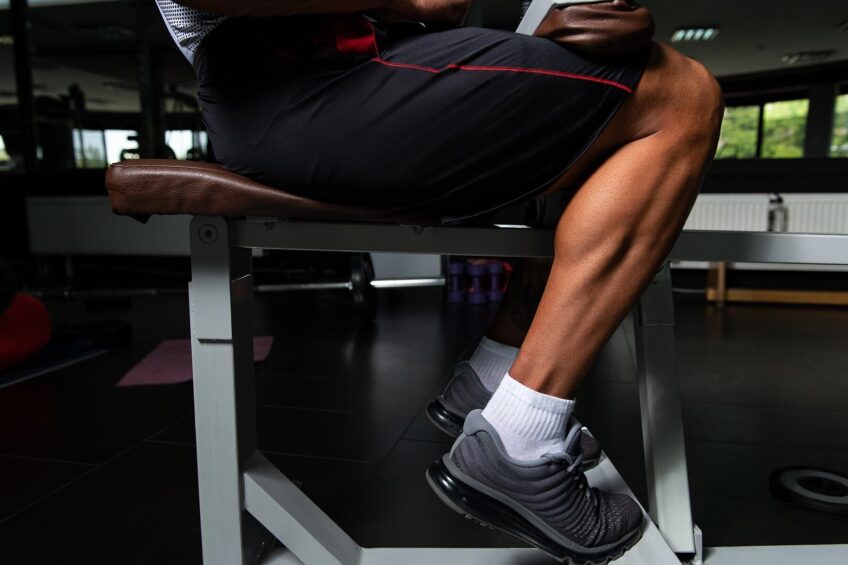
Most gyms have machines that have a padded bit across your knees. But if it doesn’t, then here’s what to do.
- Sit down with your feet shoulder-width apart.
- Place a barbell over your knees.
- Raise your heels off the floor.
- Lower your feet.
- Repeat 15-20 times, 4 sets.
Toe Raises for Calf Muscle Balance
This exercise is for your tibialis anterior, aka the tibia. This tibia machine by Titan makes an excellent addition to any home gym.
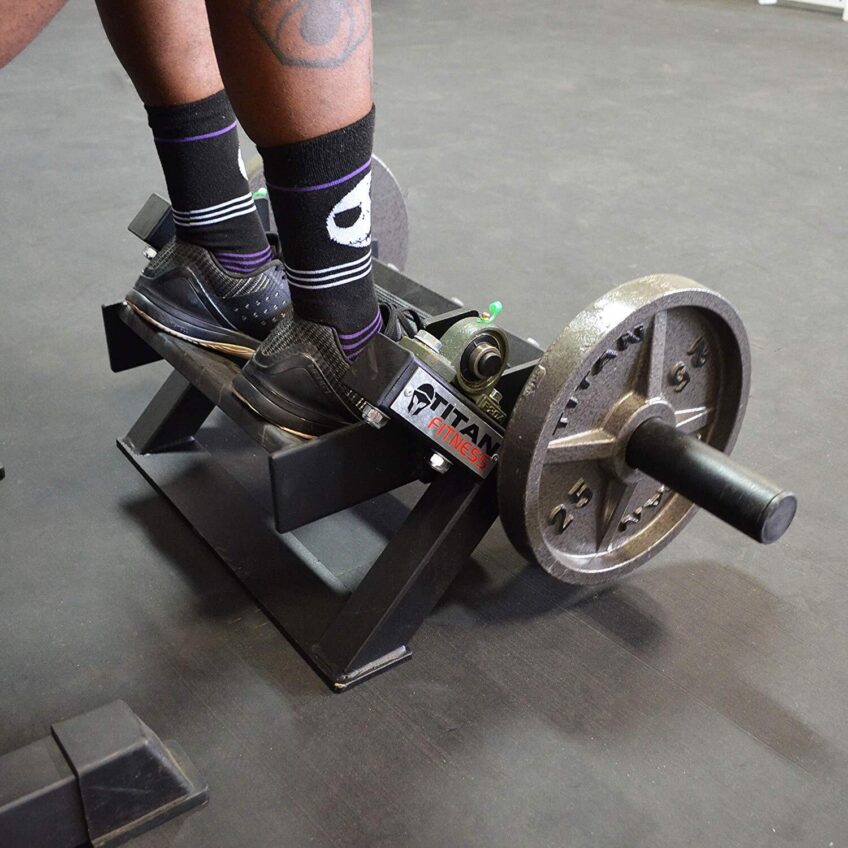
- Sit comfortably and insert your feet.
- Raise your toes as far as you can.
- Gently release back to the floor.
- Repeat 10-15 times, 4 sets.
You could also use a resistance band against a fixed point and pull your toes upwards.
Donkey Raise for Explosive Calves
This exercise also works the gastrocnemius and can be done in several ways.
- Use a raised platform and create an L with your body.
- Press down with the balls of your feet and raise your heels.
- Hold the position.
- Low your heels.
- Repeat 10 times, 4 sets.
You can increase the difficulty by adding weights or your workout partner!
Mix it Up With Cardio
The best way to build muscle is to have a varied workout routine. There are cardio exercises that will also help you to build calf muscles.
Functional cardio exercises include jump rope, squat jumps, and box jumps — where you jump on and off a platform.
Or, just get outside and go for a “hilly” run. Trail running is also great for calf muscles.
My Thoughts?
Most of us have a hard time building our calves, partially because they are used daily and also because they are made up of separate muscles that need to be worked on separately.
However, building strength in the calves will improve performance across many exercises, so it is worth spending time and energy on them.
Make yourself aware of the two muscles that make up your calf, the gastrocnemius, and the soleus, and target your workouts accordingly.
The gastrocnemius, the big muscle you feel rise as you clench, can be a workout by doing exercises involving standing while engaging your calf. Your soleus can be strengthened by doing sitting-down exercises.
When exercising, your calves focus on a large weight rather than the number of reps and do everything with good technique and control, holding positions where you can.
That being said, the best way to build any muscle is variety. Use a combination of weightlifting exercises and cardio to build strength.
You may need to incorporate these exercises into your routine twice weekly to get results if you have stubborn calves like me.
Find what works for you, and don’t give up; they are a hard muscle group to build, but it can be done using these techniques!
Tony Lee, MS, RD
Tony Lee, RD, MS, is a highly qualified and accomplished Registered Dietitian with a Master’s Degree in Nutrition Sciences. Tony brings over two decades of experience in dietetics, specializing in sports nutrition. Interests include studying all aspects of wellness, fitness, genetics, and peak health performance.










